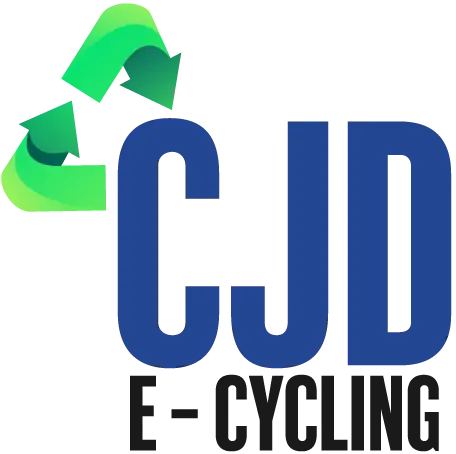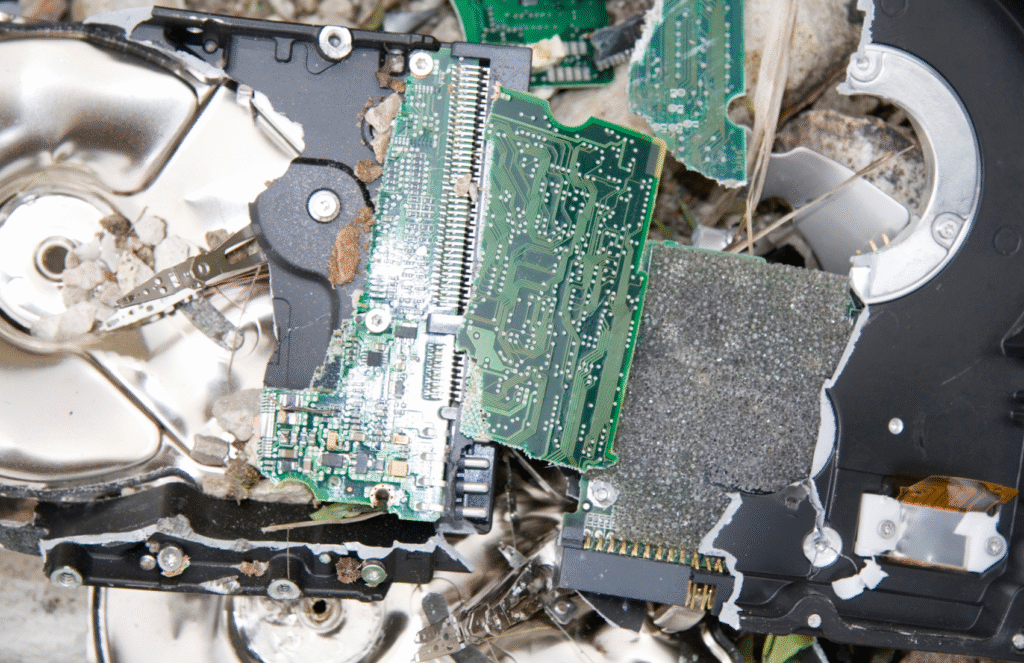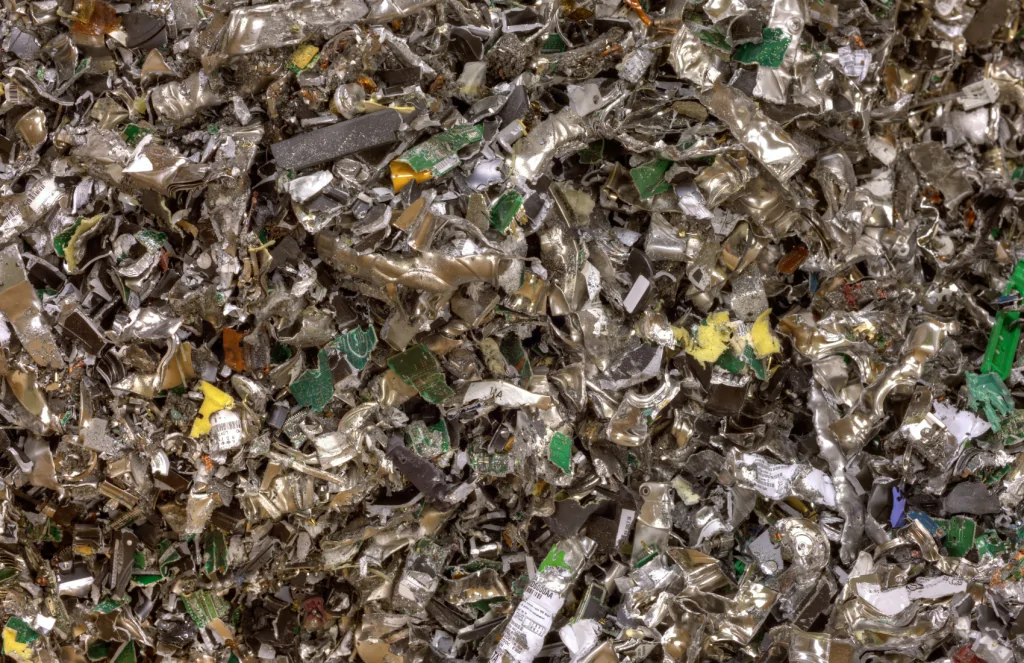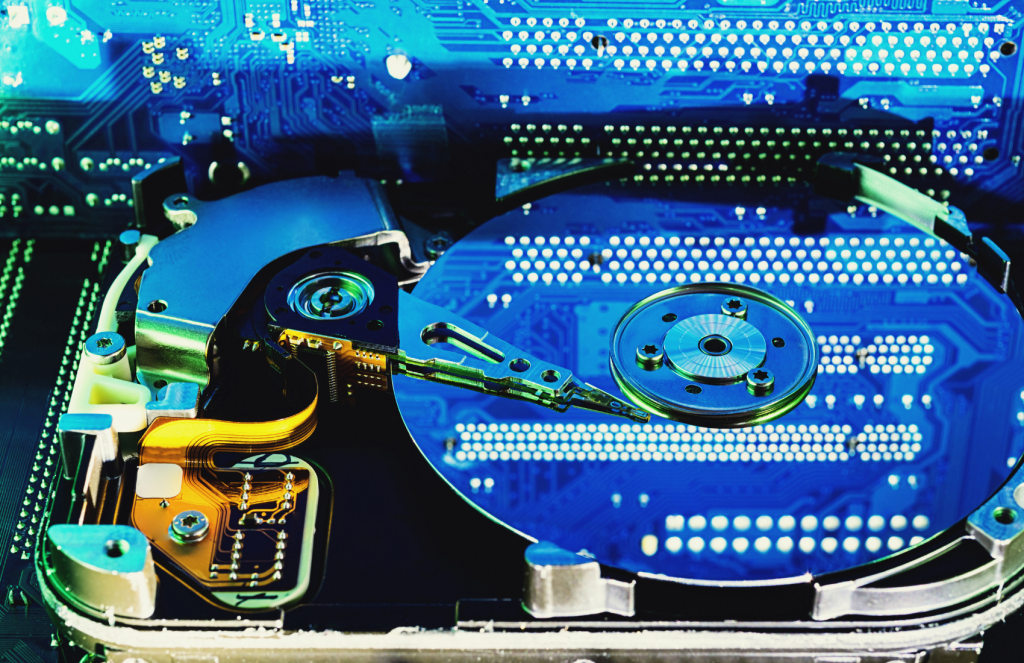Inside Our Certified Hard Drive Destruction Process: What Really Happens When You Shred a Drive
Last year, a healthcare provider in Ohio thought they’d properly disposed of old computers by donating them to a local charity. Three months later, patient records from those supposedly “wiped” hard drives appeared for sale on the dark web. The HIPAA violations cost them $4.3 million in fines, not to mention the irreparable damage to their reputation.
This isn’t a scare tactic. It’s a reality check.
When it comes to data security, simply deleting files or reformatting drives won’t cut it. At CJD E-Cycling, we’ve spent over 15 years performing certified hard drive destruction and hard drive shredding, and we’ve seen firsthand what happens when businesses cut corners on data disposal. In this guide, we’re pulling back the curtain on our entire process to show you exactly what certified destruction looks like and why it’s the only truly secure option for protecting your sensitive data.
The Myth of Deleted Data: Why “Empty Trash” Isn’t Enough
Here’s something that surprises most people: when you delete a file from your computer, you’re not actually removing the data. You’re just removing the signpost that tells your computer where to find it.
Think of it like this. Your hard drive is a massive library, and each file is a book. When you “delete” something, you’re not burning the book—you’re just removing it from the card catalog. The book is still sitting on the shelf, and anyone with basic data recovery tools can find it and read it.
Formatting a drive? That’s just slightly better. It’s like removing all the card catalogs but leaving every single book exactly where it was. Data recovery specialists can still piece together most, if not all, of your information.
We’ve tested this ourselves. In our facility, we’ve taken “wiped” drives that companies thought were clean and recovered everything from financial records to employee social security numbers to confidential client communications. It takes about 20 minutes and costs less than $50 in software.
The uncomfortable truth is that software-based deletion methods—even DoD-compliant multi-pass overwrites—can be defeated or may not work properly on modern solid-state drives due to wear-leveling technology. This is why organizations handling sensitive information have shifted to one non-negotiable standard: physical destruction through certified hard drive shredding.
What “Certified” Really Means in Hard Drive Destruction
Walk into any electronics recycling facility, and they’ll probably tell you they can destroy your hard drives. But “destruction” without certification is like getting surgery from someone who watched a few YouTube videos. The equipment might look similar, but the difference in standards, accountability, and actual security is enormous.
Certified hard drive destruction means your provider adheres to recognized industry standards and undergoes regular audits to verify compliance. The gold standard in our industry is NAID AAA Certification, which is to data destruction what organic certification is to food—a rigorous, independently verified guarantee that specific protocols are being followed.
Here’s what certification actually requires. Your destruction provider must maintain a documented chain of custody from the moment your drives leave your facility until they’re completely destroyed. Every drive gets tracked with serial numbers. Every movement is logged. Every person who touches your media is background-checked and trained. If something goes wrong, there’s a complete paper trail showing exactly what happened and who was responsible.
The certification also mandates specific destruction methods. For hard drive shredding, particles must be reduced to a maximum size that makes data recovery physically impossible. We’re talking about shredding your drives into pieces no larger than 2mm—roughly the size of a grain of rice. At that particle size, even the most sophisticated forensic recovery tools can’t reconstruct your data.
But here’s what really matters: liability protection. When we complete certified hard drive destruction for a client, we provide a Certificate of Destruction that includes serial numbers, destruction date, method used, and our certification credentials. This documentation proves to auditors, insurance companies, and regulators that you met your legal obligations for data disposal. Without that certificate from a certified provider, you’re personally liable if data from your disposed drives is ever compromised.
Red Flags Your Destruction Provider Isn’t Actually Certified:
- They can’t produce current certification documents when asked
- They won’t provide itemized certificates of destruction with serial numbers
- They offer suspiciously low prices (proper certification isn’t cheap to maintain)
- They’re vague about their destruction methods or particle size
- They don’t require chain of custody documentation
- They subcontract the actual destruction to unknown third parties
In our 15 years performing certified hard drive destruction, we’ve seen companies burned by uncertified providers who claimed to be “just as good.” They’re not. When an audit comes or a breach occurs, those businesses learn the expensive way that compliance shortcuts have very real consequences.
What Happens During Professional Hard Drive Shredding: A Behind-the-Scenes Look
People always ask us what our facility looks like. They’re usually imagining something out of a spy movie—dark rooms, mysterious equipment, people in hazmat suits. The reality is more impressive because it’s more systematic and thorough than any Hollywood portrayal.
When your hard drives arrive at our facility, they don’t just get tossed into a shredder. Every single drive goes through a documented process that would satisfy the most paranoid security professional and the strictest compliance auditor.
Step One: Secure Intake and Asset Tracking
Your drives arrive in tamper-evident containers. Before we even open them, we photograph the seals and note any irregularities. Once opened, every single drive is logged into our asset tracking system. We record the serial number, manufacturer, capacity, and your company’s asset tag if present. This creates the first link in our chain of custody documentation.
If you’re sending us 500 drives, we’re cataloging all 500 individually. Yes, it’s time-consuming. Yes, it’s necessary. This is how we guarantee that the drives you sent are the drives we destroyed—not someone else’s, not fewer than you sent, not mysteriously missing drives that could resurface at a flea market.
Step Two: Secure Storage Before Destruction
Drives waiting for destruction don’t sit in a hallway. They’re stored in our secured destruction area with restricted access, video surveillance, and environmental controls. Only authorized personnel with background checks can enter, and every entry is logged. We typically destroy drives within 48 hours of receipt, but even if there’s a delay, your data remains secure.
Step Three: The Actual Shredding Process
This is where things get dramatic. Our industrial hard drive shredder doesn’t mess around. It uses a combination of crushing force and multiple rotating shafts with tungsten-carbide teeth to pulverize drives into particles small enough to pass through a 2mm screen.
The sound is incredible—imagine a combination of a wood chipper and a rock crusher, but more violent. We wear hearing protection because the noise of metal, glass, and rare earth magnets being simultaneously torn apart reaches well over 100 decibels.
A single hard drive takes about 15-30 seconds to completely destroy. The drive goes in whole, and what comes out looks like metallic confetti mixed with black powder. You could spread the remains of your drive across a table, and you’d never identify a single data platter fragment large enough to contain recoverable information.
For solid-state drives (SSDs), the process is the same but even more critical. SSDs store data on memory chips that remain intact even if you break the circuit board. Our shredding process doesn’t just break the chips—it grinds them into particles too small to identify, let alone read.
Step Four: Material Separation and Responsible Recycling
Here’s something many people don’t realize: certified hard drive shredding isn’t the end of the process. Those shredded particles contain valuable materials—aluminum from the cases, precious metals from the circuit boards, rare earth magnets from the motors, and small amounts of gold and silver from connectors.
After shredding, the material goes through our separation process. Magnets pull out ferrous metals, eddy current separators remove aluminum, and specialized equipment isolates the precious metal-bearing components. Every material stream gets sent to downstream recyclers who extract the raw materials for reuse in new manufacturing.
This is where certified destruction and responsible e-cycling intersect. Your destroyed drives don’t end up in a landfill. They become raw materials for new products, reducing the environmental impact of mining and manufacturing while ensuring your data is permanently, irreversibly destroyed.
Step Five: Certificate of Destruction
Within 24-48 hours of destruction, you receive your Certificate of Destruction. This isn’t a generic form letter. It’s a detailed document that includes every serial number we destroyed, the date and method of destruction, the name of the certified technician who performed the destruction, and our certification credentials.
This certificate is your proof of compliance. File it with your data security documentation because if you’re ever audited or face a data breach investigation, this certificate demonstrates that you took reasonable and industry-standard measures to protect sensitive information.
Who Needs Certified Hard Drive Destruction?
If you’re thinking this level of security sounds like overkill for your business, consider whether you handle any of these types of information: customer names and addresses, payment card data, social security numbers, medical records, employee files, trade secrets, legal documents, or any information you’d be embarrassed to see published online.
If you answered yes to any of those, you need certified hard drive destruction. But certain industries face specific regulatory requirements that make certified destruction not just smart but legally mandatory.
Healthcare Organizations: HIPAA requires covered entities to ensure that electronic protected health information (ePHI) is properly destroyed and unreadable. Certified hard drive destruction with documented certificates meets this requirement. Anything less opens you up to fines starting at $100 per violation, up to $1.5 million per year for each violation category.
Financial Services: Banks, credit unions, investment firms, and anyone handling financial data face GLBA requirements and PCI-DSS compliance standards. Both require documented destruction of devices containing customer financial information. Certified shredding provides the documentation you need to prove compliance during audits.
Legal Firms: Attorney-client privilege doesn’t end when a case closes. Old hard drives containing client communications require the same confidentiality protections as active files. Certified destruction ensures privileged information remains protected even after disposal, protecting both your clients and your liability exposure.
Government Contractors: If you handle CUI (Controlled Unclassified Information) or any government data, NIST SP 800-88 guidelines require specific methods for media sanitization. Physical destruction is one of the approved methods, but it must be documented. Certified hard drive shredding meets these requirements and provides the documentation needed for contract compliance.
Education Institutions: Schools and universities maintain extensive records on students, employees, and research subjects. FERPA and various research data protection requirements mandate secure disposal of electronic records. Given the volume of devices educational institutions cycle through, certified destruction programs are essential.
Any Business with Customer Data: Even if you’re not in a heavily regulated industry, data breach notification laws in all 50 states create liability for companies that fail to adequately protect customer information. When disposing of equipment, certified destruction demonstrates reasonable security measures, potentially limiting your liability if a breach occurs.
The cost of certified hard drive destruction is minimal compared to the potential fines, lawsuits, and reputation damage from a data breach involving improperly disposed equipment. We’re talking about $5-$15 per drive for certified destruction versus millions in potential liability.
On-Site vs. Off-Site Hard Drive Shredding: Choosing the Right Service
One of the first decisions you’ll make is whether to bring us to your location or send drives to our facility. Both options provide certified destruction, but they serve different needs and security requirements.
Off-site destruction is what we’ve described so far. You pack your drives in secure containers, we transport them to our facility with chain of custody documentation, and we destroy them in our controlled environment. This approach offers cost efficiency for most organizations because our facility equipment can process high volumes quickly, and you’re not paying for mobile equipment and technician travel time.
Off-site works well when you have regular disposal needs, when cost efficiency matters, and when your data sensitivity requirements are met by documented chain of custody controls. Most of our healthcare, financial, and business clients choose off-site destruction because it balances security, compliance, and budget considerations.
On-site destruction brings our mobile shredding equipment to your location. You watch as we destroy your drives right there in your parking lot. Nothing leaves your facility until it’s been shredded into 2mm particles in front of your eyes.
On-site makes sense for organizations with heightened security requirements, for highly sensitive government or defense contractor data, for businesses in remote locations where transportation adds significant time and risk, or when internal policies require witnessed destruction. The trade-off is cost—mobile services typically run 30-50% higher due to equipment, travel, and time requirements.
At CJD E-Cycling, we offer both services because we recognize that different organizations have different security models. A regional medical practice might be perfectly comfortable with our off-site certified process, while a defense contractor working on classified systems might require on-site witnessed destruction. Both options provide the same level of actual security—the difference is about risk tolerance, internal policy requirements, and budget.
Certified Destruction Meets Responsible E-Cycling
Here’s something we’re proud of: every hard drive we destroy gets recycled responsibly. Certified hard drive shredding and environmental responsibility aren’t competing priorities. They’re two sides of the same commitment to doing things the right way.
After your drives are shredded and your data is irreversibly destroyed, those materials begin a second life. The aluminum cases get melted down and reformed into new products. The rare earth magnets, which are environmentally costly to mine, get recovered and reused in new motors and electronics. The circuit boards, which contain small amounts of gold, silver, copper, and palladium, go to specialized recyclers who extract those precious metals for reuse in manufacturing.
Even the steel from drive motors and the glass from platters gets recycled. Nothing goes to a landfill. Nothing gets shipped overseas to developing countries where it might be processed unsafely. Every material stream from our destruction process goes to vetted, certified downstream recyclers.
This matters because electronic waste is one of the fastest-growing waste streams globally, and hard drives contain materials that shouldn’t end up in landfills. Lead in solder, trace amounts of various heavy metals, and rare earth elements can create environmental problems if not properly managed. Responsible e-cycling ensures these materials stay in the circular economy rather than becoming pollution.
At CJD E-Cycling, we believe that secure destruction and environmental responsibility go hand-in-hand. You shouldn’t have to choose between protecting your data and protecting the environment. Our certified process delivers both, giving you security, compliance, and the peace of mind that comes from knowing your old drives are being handled responsibly from start to finish.
10 Critical Questions Before Choosing a Hard Drive Destruction Service
Not all destruction providers are created equal. Before trusting anyone with your sensitive data, ask these questions and evaluate their answers carefully.
1. What certifications do you hold, and can you provide current documentation? Look for NAID AAA Certification specifically. Ask to see their certificate and verify it’s current. Certifications expire, and some providers let them lapse but keep claiming certified status.
2. What is your chain of custody process? They should be able to describe exactly how drives are tracked from pickup through destruction, including how they handle serial number documentation and secure transport procedures.
3. What particle size do you shred hard drives to? The answer should be 2mm or smaller. If they’re vague about this or claim larger particles are “good enough,” that’s a red flag about the quality of their equipment and processes.
4. Do you provide itemized certificates of destruction with serial numbers? Generic certificates without serial numbers are worthless for compliance purposes. You need documentation that proves your specific drives were destroyed.
5. Are you insured and bonded? Your provider should carry comprehensive liability insurance and be bonded in case something goes wrong. Ask about coverage limits and request proof of current insurance.
6. How do you handle different drive types like SSDs, M.2 drives, and hybrid drives? Technology evolves, and your provider needs to understand how different storage technologies store data and require different verification approaches during destruction.
7. What are your facility security protocols? If you’re using off-site destruction, ask about facility access controls, video surveillance, background checks on personnel, and how they secure drives before destruction.
8. How do you handle environmental disposal of shredded materials? Responsible providers should recycle materials through certified downstream processors. They should be able to tell you exactly where different material streams go after shredding.
9. Can you accommodate our volume and scheduling needs? Make sure they can handle your destruction requirements without compromising security. A provider who’s overwhelmed and cutting corners to keep up is a provider who’ll eventually make a costly mistake.
10. What documentation do you provide for compliance audits? Beyond certificates of destruction, ask about what other documentation they maintain and whether they can provide supporting records if you face an audit years down the road.
These questions help you separate legitimate certified providers from companies that are just going through the motions. A professional provider will welcome these questions and provide detailed, confident answers. Anyone who gets defensive or vague probably isn’t maintaining the standards you need.
Your Data Deserves Better Than “Delete”
Data security doesn’t end when equipment gets old. In fact, that’s when your risk actually increases. Old drives sitting in closets, donated computers with “wiped” drives, or disposed equipment without proper destruction—these are the weak links where data breaches happen.
Certified hard drive destruction closes that security gap. It ensures your data is destroyed using industry-standard methods, documented with compliance-ready certificates, and handled by providers who’ve proven their commitment to security through independent audits and certification.
At CJD E-Cycling, we’ve built our reputation on doing this one thing exceptionally well. Every hard drive we destroy goes through the same rigorous process, whether you’re a small business disposing of a handful of drives or a large enterprise managing thousands of devices. Your data gets the same level of certified protection, the same documentation, and the same commitment to security and environmental responsibility.
We don’t cut corners. We don’t skip steps. We don’t assume that “good enough” is acceptable when it comes to protecting your sensitive information. Because we’ve seen what happens when data disposal goes wrong, and we’ve made it our mission to ensure it never happens to our clients.
Ready to properly protect your data? Contact CJD E-Cycling today for a quote on certified hard drive destruction and shredding services. Call us at [phone number] or visit [contact page] to discuss your specific needs. We’ll help you develop a destruction program that meets your compliance requirements, fits your budget, and gives you complete confidence in your data security.
Your data is valuable when it’s active. It’s a liability when it’s not properly destroyed. Let us help you eliminate that liability with certified hard drive destruction you can document, audit, and trust.



